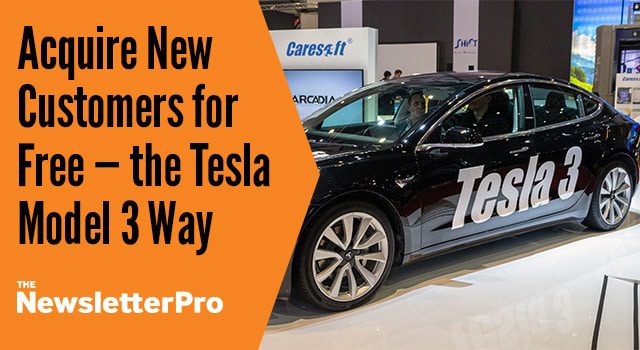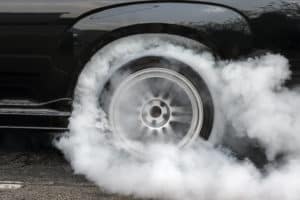Today, I want to share with you the origins of our Tesla referral program. Our model is based on Elon Musk’s genius marketing promotion.

Have you ever felt like some people are treated differently based on notoriety? Elon Musk, for example, can get free PR whenever he wants. He just hops on Twitter and says something. Anything. Likewise, Uber violated laws in hundreds of cities when it first started, and no one got arrested.
But, when us small business guys make one little mistake, the world comes down on us like a ton of bricks. It doesn’t seem fair, but that is life, right?
So what? You and I can’t get the PR of Musk or risk breaking laws like Uber. But, that doesn’t mean we can’t use some of the elite’s tactics to grow our businesses.
The $500 Million Idea
 One of my favorite tactics is a referral spin on Musk’s Model 3 promotion.
One of my favorite tactics is a referral spin on Musk’s Model 3 promotion.
To grow Tesla, Musk continuously needs a massive amount of cash. For example, he wants to build Gigafactories to produce lithium-ion batteries. What’s a guy to do when he needs a billion dollars to complete a battery factory, interest free?
He unveils the Model 3. We can use a similar tactic to generate customers almost for free, turn a profit on them, and then pay a reduced customer acquisition cost. If that sounds good, keep reading.
To tell this story properly, I’m going to have to take you back in time.
The year was 2016, and Elon Musk needed some cash, as he often does.
There was a new battery factory in development and a massive burn rate that needed to be fed.
You’d think that, as a billionaire, his money troubles would go away. But to this day, his burn rate is thousands of dollars a minute.
At the time, selling more cars was not going to be the solution to the issue. Musk, being the genius he is, developed the brand-new Tesla Model 3. Although a Model 3 was years away from being built, a $35,000 Tesla was too good to ignore.
Musk knew that if he got his message out to the world, people would flock en masse to reserve one. So, he flexed his PR muscle, and low and behold, 550,000 people gave him a deposit of $1,000 to reserve a car that was years away from production. That’s $550,000,000 in deposits. It really was a stroke of genius.
Pedal to the Metal
 It wasn’t only money that Musk got. As a suave entrepreneur, he realized he had an amazing leads list. With a little email marketing, some direct mail, and a bunch of salespeople, he could likely upgrade some of those deposits to full paying customers.
It wasn’t only money that Musk got. As a suave entrepreneur, he realized he had an amazing leads list. With a little email marketing, some direct mail, and a bunch of salespeople, he could likely upgrade some of those deposits to full paying customers.
Good news for Musk: He was right, and 8% of the people who paid a deposit upgraded to a higher-end Tesla. With a minimum cost per new Model S or X of $75,000, Musk was able to generate another $3.3 billion dollars in sales. Not too shabby.
Of course, it wasn’t all good news; some people got tired of waiting for their cars and asked for their money back. But according to Musk, that group amounts to 12% of customers in the last 28 months. That’s a great attrition rate and a loss of only $66,000,000 — a virtual drop in the bucket compared to the 3.85 billion dollars brought in from sales and deposits.
Of course, now that Model 3s are rolling off the factory line at regular intervals, there are hundreds of thousands of people willing to pay $39,000 or more for a car at some point. Assuming most of them actually pull the trigger, that’s billions of dollars in the bank for Tesla.
Now, you and I may not be creating products as high-end as a Tesla. We may not make billions of dollars. But, we can use some of the same money math to grow our companies.
A Model You Can Follow
 The simplest case study to look at is our Tesla referral program, which you should totally register to be a part of at NewsletterPro.com/tesla.
The simplest case study to look at is our Tesla referral program, which you should totally register to be a part of at NewsletterPro.com/tesla.
Here’s some background info on the referral program and the economics behind it.
We’re giving away a Tesla Model S or X to someone who sends us a referral who signs up for any of our custom newsletter packages. We’re also giving away $500 cash to each person who refers ($50,000 total) once we reach 100 new referrals.
Of course, it seems scary to give away a car and have a $50,000 liability in cash prizes, but when you think about it, this is some of the safest marketing ever.
Like Musk, in order to promote our referral program, we had to invest a little money up front, and we needed to already have media in place. We don’t accrue much expense for each new customer until after they give us money. At that point, we owe $500 to the person who referred that new customer to us.
Ultimately, we have to buy a car, but only after we get 100 referrals, which we estimate will take around 12 months. (We’re getting there — and getting there fast!) At that point, our new customers will have been paying us for a year before we have to purchase the vehicle, which allows us to offer a killer prize with minimum risk.
Our referral program does the same thing Musk does, just with referrals instead of product deposits. If we had to buy the car first, the risk would be so high that we’d never take the chance. The reality is that not all marketing campaigns work, even for me.
But if we don’t have to shell out most of the money until after we already have the customer, it is virtually risk-free for us.
Are You Supercharged and Ready to Go?
 If your wheels are spinning on how you can also use these strategies to give away a car or some other killer prize in your own referral program, that’s great. If you want it to be successful, there are two things you must do ASAP: You need to make sure you have media that you own and control (like a newsletter, hint hint), and you need to make sure you’re using that media to build relationships with your customers and prospects.
If your wheels are spinning on how you can also use these strategies to give away a car or some other killer prize in your own referral program, that’s great. If you want it to be successful, there are two things you must do ASAP: You need to make sure you have media that you own and control (like a newsletter, hint hint), and you need to make sure you’re using that media to build relationships with your customers and prospects.
Ideally, you shouldn’t launch both the referral program and the media/relationship platform at the same time. You really need the relationship first.



